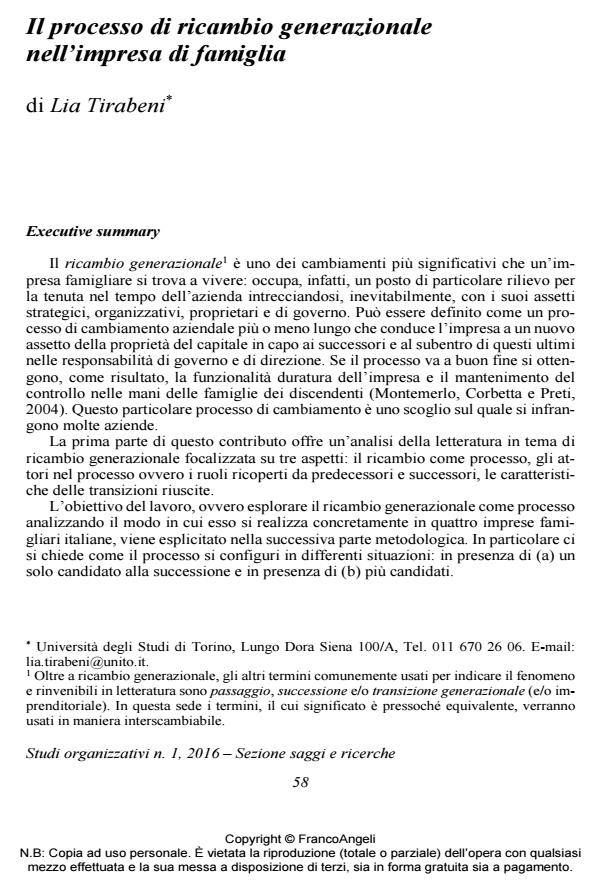Il processo di ricambio generazionale nell’impresa di famiglia
Titolo Rivista STUDI ORGANIZZATIVI
Autori/Curatori Lia Tirabeni
Anno di pubblicazione 2016 Fascicolo 2016/1
Lingua Italiano Numero pagine 33 P. 58-90 Dimensione file 275 KB
DOI 10.3280/SO2016-001003
Il DOI è il codice a barre della proprietà intellettuale: per saperne di più
clicca qui
Qui sotto puoi vedere in anteprima la prima pagina di questo articolo.
Se questo articolo ti interessa, lo puoi acquistare (e scaricare in formato pdf) seguendo le facili indicazioni per acquistare il download credit. Acquista Download Credits per scaricare questo Articolo in formato PDF

FrancoAngeli è membro della Publishers International Linking Association, Inc (PILA)associazione indipendente e non profit per facilitare (attraverso i servizi tecnologici implementati da CrossRef.org) l’accesso degli studiosi ai contenuti digitali nelle pubblicazioni professionali e scientifiche
Il ricambio generazionale è uno dei cambiamenti più significativi che un’impresa famigliare si trova a vivere: occupa, infatti, un posto di particolare rilievo per la tenuta nel tempo dell’azienda intrecciandosi, inevitabilmente, con i suoi assetti strategici, organizzativi, proprietari e di governo. Può essere definito come un processo di cambiamento aziendale più o meno lungo che conduce l’impresa a un nuovo assetto della proprietà del capitale in capo ai successori e al subentro di questi ultimi nelle responsabilità di governo e di direzione. Se il processo va a buon fine si ottengono, come risultato, la funzionalità duratura dell’impresa e il mantenimento del controllo nelle mani delle famiglie dei discendenti (Montemerlo, Corbetta e Preti, 2004). Questo particolare processo di cambiamento è uno scoglio sul quale si infrangono molte aziende. La prima parte di questo contributo offre un’analisi della letteratura in tema di ricambio generazionale focalizzata su tre aspetti: il ricambio come processo, gli attori nel processo ovvero i ruoli ricoperti da predecessori e successori, le caratteristiche delle transizioni riuscite. L’obiettivo del lavoro, ovvero esplorare il ricambio generazionale come processo analizzando il modo in cui esso si realizza concretamente in quattro imprese famigliari italiane, viene esplicitato nella successiva parte metodologica. In particolare ci si chiede come il processo si configuri in differenti situazioni: in presenza di (a) un solo candidato alla successione e in presenza di (b) più candidati. Come strategia di ricerca si è optato per lo studio di caso (Yin, 2002) adottando, in particolare, un multiple case design che offre maggiore solidità ai risultati (Eisendhardt, 1989). Nella fase di analisi, dopo la descrizione del profilo di ciascun caso, si sono indentificati i principali tratti, delineati anche in letteratura, che accomunano tutti i processi di ricambio vissuti dalle aziende analizzate. Sulla base del decision-making process originariamente elaborato da Simon (1977), viene poi ricostruito e analizzato ciascun ricambio come un processo caratterizzato da fasi in cui successori e predecessori ricoprono di volta in volta ruoli diversi. Il modello proposto mostra come ciascun processo si configuri, in modo tipico ideale, in maniera differente a seconda che vi sia solo un candidato o più di uno alla successione. Il lavoro si chiude con alcune proposizioni volte a indirizzare future ricerche offrendo spunti di riflessione teorici e pratici.
Parole chiave:Ricambio generazionale, impresa famigliare, successione imprenditoriale, studio di caso, processo di decision-making.
- Diversity and Inclusion in Italy Lia Tirabeni, Daniel Pittino, pp.209 (ISBN:978-3-031-81937-7)
Lia Tirabeni, Il processo di ricambio generazionale nell’impresa di famiglia in "STUDI ORGANIZZATIVI " 1/2016, pp 58-90, DOI: 10.3280/SO2016-001003